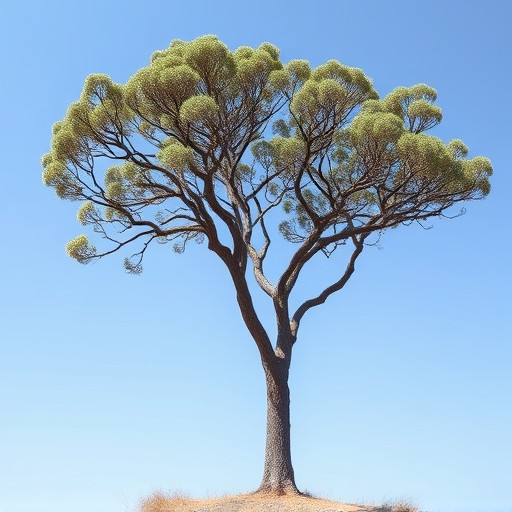California's native Acacia species are highly adaptable and diverse, thriving in various habitats from arid regions to coastal zones. They differ from Indian Acacias in foliage patterns, growth habits, and floral displays, contributing significantly to local ecosystems and biodiversity. While California's Acacia californica has thick, waxy leaves for Mediterranean climates, Indian varieties like Acacia nilotica adapt with broader leaves and deep roots to stabilize soil during heavy rainfall. The Indian Acacia is also known for its versatile uses, from crafting tools to sustainable biofuel.
Acacia in California: A Native Beauty vs. Its Exotic Cousin from India
The Acacia tree, a native species in California, showcases remarkable adaptations to the region’s climate and ecosystems. Unlike its exotic cousin, the Indian Acacia, this local variety has evolved unique characteristics. This article explores the distinct features of California’s Acacia, from its distribution and varieties to its structural differences and roles within the ecosystem. By comparing these two types, we uncover the fascinating variations in leaf shape, thorn presence, and bark texture, providing insights into their respective origins and preferences for sunny climates.
- California's Acacia: A Native Species
- – Distribution and habitat in California
- – Varieties native to the region and their unique adaptations
- The Indian Acacia: An Exotic Cousin
California's Acacia: A Native Species

California’s native Acacia species play a unique role in its diverse ecosystem. Unlike their distant cousins from India, these trees have adapted to the specific conditions of the Golden State. The California Acacias are known for their resilience and variety; they can thrive in various habitats, from dry, rocky slopes to coastal areas. This adaptability has allowed them to flourish and become an integral part of the state’s natural beauty.
These native trees often display distinct characteristics that set them apart from their Indian counterparts. Their foliage might vary in shape and texture, with some species featuring intricate patterns and unique growth habits. The flowers, a signature feature of Acacia, can also differ greatly, ranging from delicate clusters to vibrant displays, attracting local wildlife and contributing to the region’s biodiversity.
– Distribution and habitat in California

The Acacia tree, native to California, thrives in a diverse range of habitats across the state. Its distribution is vast, stretching from the arid regions in the south to the more temperate areas in the north. This adaptability is due to its various species, each with specific environmental requirements. In California, Acacias are often found in dry forests, scrublands, and even coastal zones, showcasing their versatility in surviving different climatic conditions. These trees play a vital role in shaping the state’s unique ecosystems by providing shelter for wildlife and contributing to soil stabilization.
– Varieties native to the region and their unique adaptations

The Acacia tree, native to both California and India, presents distinct characteristics shaped by their unique environments. California’s varieties, such as the Acacia californica (or the California acacia), have developed specialized adaptations to survive the region’s Mediterranean climate. These trees often grow in dry, arid conditions, characterized by long, hot summers and relatively mild winters. As a result, they have thick, waxy leaves that reduce water loss and deep taproots for accessing groundwater. The bark is also rough and fissured, providing protection against extreme temperatures and fire.
In contrast, Indian Acacia species, like the Acacia nilotica, are well-adapted to the country’s diverse ecosystems, including arid deserts and tropical forests. These trees have broader leaves with dense hairs to minimize water loss, and they often grow in closer proximity to other plants, benefiting from mutualistic relationships for support and nutrient exchange. The Indian varieties also produce deep-growing roots that help stabilize the soil during monsoons and heavy rainfall, preventing erosion.
The Indian Acacia: An Exotic Cousin

The Indian Acacia is a striking and versatile species, closely related yet distinct from its California counterpart. Native to the subcontinent, this tree has adapted to thrive in diverse environments, from arid deserts to lush forests. Its robust branches and feathery leaves are well-adapted to withstand harsh conditions, making it an enduring symbol of resilience.
Compared to the Californian Acacia, the Indian variety often presents with a more compact growth pattern, reaching heights suitable for both urban landscapes and natural habitats. The tree’s wood is renowned for its hardness and durability, leading to various traditional and modern applications, from crafting tools and furniture to serving as a source of sustainable biofuel.
The Acacia tree, native to California, stands as a unique addition to the region’s biodiversity with its adapted varieties. Unlike its Indian counterpart, this local species has evolved specific traits to thrive in California’s climate and ecosystems. Understanding these differences is crucial for conservation efforts and appreciating the diverse natural world around us.
